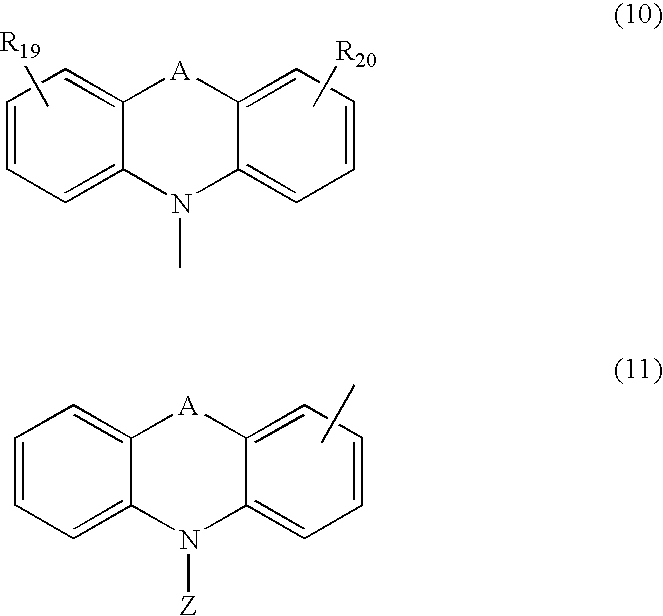Material for organic electroluminescent device and organic electroluminescent device using same
a technology of electroluminescent devices and materials, which is applied in the direction of discharge tube luminescnet screens, natural mineral layered products, etc., can solve the problems of symmetrical structure, too symmetrical to avoid the generation of crystal growth, and the tendency of the host compound to crystallize, etc., to achieve superior heat resistance, prolong the life, and enhance the efficiency of light emission
- Summary
- Abstract
- Description
- Claims
- Application Information
AI Technical Summary
Benefits of technology
Problems solved by technology
Method used
Image
Examples
synthesis example 1 (
Synthesis of Compound (C5))
[0129] The route for synthesis of Compound (C5) is shown in the following.
(1) Synthesis of Intermediate Compound (IM1)
[0130] Placing 3,3′-dibromobiphenyl in an amount of 50 g (160 mmol), carbazole in an amount of 18.4 g (110 mmol), copper iodide 3.0 g (16 mmol), potassium phosphate in an amount of 46.6 g (220 mmol), trans 1,2-cyclohexanediamine in an amount of 18.2 g (160 mmol) and 1,4-dioxane in an amount of 500 milliliter into a three neck flask having a capacity of 1 liter, the resultant solution was stirred under an atmosphere of argon gas at a temperature of 105° C. for 12 hours. Afterwards, cooling the reacted solution down to a room temperature and adding 160 milliliter of water, extractions were conducted with the use dichloro-methane for 3 times. After drying an organic layer with the use of unhydride magnesium sulfate, the solvent was concentrated under reduced pressure.
[0131] Treating residues in a silicagel column, dicarbazolyl substance, ...
synthesis example 2 (
Synthesis of Compound (C8))
[0137] The route for synthesis of Compound (C8) is shown in the following.
[0138] Under the atmosphere of Argon gas, 3,5-dibromobiphenyl in an amount of 6.2 g (20 mmol), para-(carbazoly-9-yl) phenylboronic acid in an amount of 5.8 g (20 mmol), tetrakistriphenylphosphinepalladium 0 valence (Pd(PPh3)4) in an amount of 460 mg (0.4 mmol), dimethoxyethane in an amount of 100 milliliter and 10% by weight aqueous solution of sodium carbonate in an amount of 64 g (60 mmol) were placed into a three neck flask with a capacity of 200 milliliter, and the resultant solution was stirred at a temperature of 78° C. for 10 hours.
[0139] After completion of the reaction, the solution was cooled down to a room temperature and precipitated solids were separated by filtration. Adding toluene in an amount of 100 milliliter into the filtrate, an organic layer was washed by means of a separatory funnel with a use of water and a saturated solution of sodium chloride successively....
synthesis example 3 (
Synthesis of Compound (C14))
[0145] The route for synthesis of Compound (C14) is shown in the following.
(1) Synthesis of Intermediate Compound (IM5)
[0146] Under the atmosphere of argon gas, 1-bromo-3-iodebenzene in an amount of 5.0 g (18 mmol), para-(carbazolyl-9-yl) phenylboronic acid in an amount of 5.2 g (18 mmol), tetrakistriphenylphosphinepalladium 0 valence (Pd(PPh3)4) in an amount of 414 mg (0.36 mmol), dimethoxyethane in an amount of 100 milliliter and 10% by weight aqueous solution of sodium carbonate in an amount of 58 g (54 mmol) were placed into a three neck flask with a capacity of 300 milliliter, and the resultant solution was stirred at a temperature of 80° C. for 12 hours. After completion of the reaction, the solution was cooled down to a room temperature and adding toluene in an amount of 100 milliliter into the filtrate, an organic layer was washed by means of a separatory funnel with a use of water and a saturated solution of sodium chloride successively. The ...
PUM
| Property | Measurement | Unit |
|---|---|---|
| glass transition temperature | aaaaa | aaaaa |
| work function | aaaaa | aaaaa |
| thickness | aaaaa | aaaaa |
Abstract
Description
Claims
Application Information
 Login to View More
Login to View More - R&D
- Intellectual Property
- Life Sciences
- Materials
- Tech Scout
- Unparalleled Data Quality
- Higher Quality Content
- 60% Fewer Hallucinations
Browse by: Latest US Patents, China's latest patents, Technical Efficacy Thesaurus, Application Domain, Technology Topic, Popular Technical Reports.
© 2025 PatSnap. All rights reserved.Legal|Privacy policy|Modern Slavery Act Transparency Statement|Sitemap|About US| Contact US: help@patsnap.com



